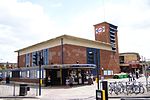Slave Labour (mural)
Slave Labour is a mural that was painted by a British graffiti artist, Banksy, on the side wall of a Poundland store in Wood Green, London in May 2012. The artwork is 48.03 inches (122 cm) high by 59.84 inches (152 cm) wide, and depicts an urchin child at a sewing machine assembling a bunting of Union Jack patches. The work was a protest against the use of sweatshops to manufacture Diamond Jubilee and London Olympics memorabilia in 2012.In February 2013 the mural was removed from its location and put up for sale at Fine art Auctions in Miami, US. After an appeal from the residents of Wood Green the mural was withdrawn from sale in the US and returned to the UK. It was sold at an auction in Covent Garden, London for (USD) $1.2 million.
Excerpt from the Wikipedia article Slave Labour (mural) (License: CC BY-SA 3.0, Authors).Slave Labour (mural)
High Road, London Harringay
Geographical coordinates (GPS) Address Nearby Places Show on map
Geographical coordinates (GPS)
| Latitude | Longitude |
|---|---|
| N 51.5911 ° | E -0.1037 ° |
Address
Poundland
High Road
N22 6BX London, Harringay
England, United Kingdom
Open on Google Maps











